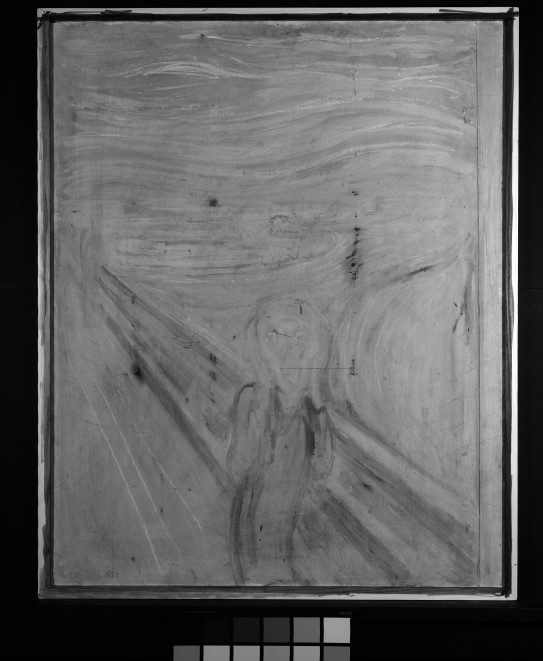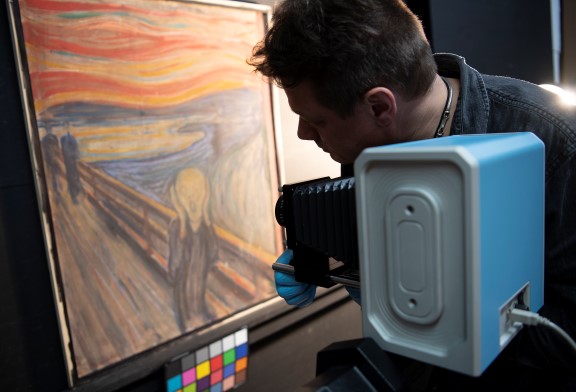Text by communications advisor Alv Hågård Gustavsen
Munch's early images created outrage and debate in their day, about 120 years ago. The first time the inscription is mentioned was in connection with an exhibition in Copenhagen in 1904, eleven years after Munch painted The Scream in 1893. At that time a Danish art critic thought a member of the public had written it. It is easy to imagine an indignant viewer, when faced with The Scream, taking a pencil and expressing their opinion on both the artwork and its creator. But that was not the case.
New research at the National Museum reveals that the handwriting belonged to Edvard Munch himself.
Mai Britt Guleng, curator at the National Museum, has worked extensively on Edvard Munch’s works. The Scream is one of several works that have been conserved and examined since the old National Gallery closed. Among other things, the painting was photographed using an infrared camera, making the writing clearly stand out from the painted background and thereby adding a new twist to the story.
There is no doubt that the inscription is Munch's. The handwriting itself and events which occurred wh en Munch exhibited the painting for the first time in Norway support this conclusion, says Guleng.
"You have to get quite close to see the inscription. We seldom find such inscriptions on paintings, particularly not on one of the world's most famous ones. Given that it's such an important work in the history of international art, the inscription has received remarkably little attention."
Infrared art photography: some technical aspects
Infrared photos are commonly used to detect whatever is hidden in a painting. This can include changes in composition or elements that have been painted over, and enables us to study how an artist arrived at the final motif.
The National Museum's version of The Scream is the first. On the back of the painting there is a partial version with a slightly different composition. Munch rejected this, turned the canvas over and painted The Scream as we know it today. The infrared photography of the painting did not reveal any unknown sketches or overpaintings, but the barely visible inscription became much clearer.
"The writing has always been visible to the naked eye, but it's been very difficult to interpret. Through a microscope, you can see that the pencil lines are physically on top of the paint and have been applied after the painting was finished," says Thierry Ford, paintings conservator at the National Museum.
"We chose to photograph it with an infrared camera to get a clearer picture of the inscription. In an infrared photo, the carbon from the pencil stands out more clearly and makes handwriting analysis easier. And you don't have to impact the painting itself."
Background: Kristiania 1895
In October 1895, Munch exhibited The Scream for the first time to a Norwegian audience at the art dealer Blomqvist. The Scream had been shown at several exhibitions abroad since it was painted in 1893, but this was the first time a domestic audience could meet what would become one of the world's most iconic works of art.
The exhibition provoked sharp criticism. Henrik Grosch, then director of the Norwegian Museum of Decorative Arts and Design and art critic, wrote that the paintings showed that one can no longer "consider Munch a serious man with a normal brain". This view was shared by several others in public.
In connection with the exhibition and the criticism, the Student Society in Kristiania held a discussion evening about Munch's art. The background was the criticism the exhibition had generated.
At the Student Society, the poet Sigbjørn Obstfelder, among others, spoke warmly about Munch's art, while others were directly critical. Medical student Johan Scharffenberg questioned Munch's mental state. More specifically, he referred to Self-Portrait with Cigarette, which Scharffenberg believed indicated that Munch was not a normal human being.
This affected Munch, who was probably present himself that evening. As late as the 1930s, Munch brought up this episode several times and his notes are full of self-defence.
"The theory is that Munch wrote this after hearing Scharffenberg's judgment on his mental health, sometime in or after 1895. It is reasonable to assume that he did it quite soon after, either during or following the exhibition in Kristiania," says Mai Britt Guleng, curator at the National Museum.
"Munch was also generally concerned about the idea of hereditary disease in the family. Both his father and grandfather suffered from what was then referred to as melancholy and his sister Laura Munch had been admitted to Gaustad Psychiatric Hospital."
The confirmation that the inscription was made by Munch himself now allows for different interpretations of Munch's creativity and his relationship to his own art.
"The inscription can be read as an ironic comment, but at the same time as an expression of the artist's vulnerability. Writing on the finished painting shows that creating for Munch was a continuous process," says Guleng.
Self-Portrait with Cigarette was purchased by the National Gallery after the exhibition in 1895. The public will be able to view this painting and The Scream when the new National Museum opens in 2022.



